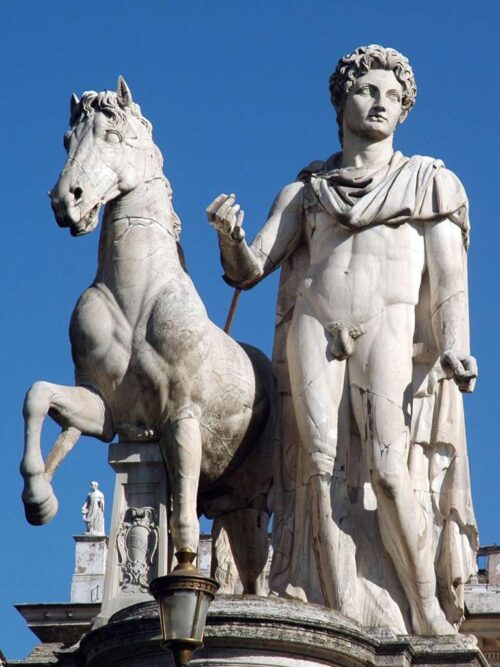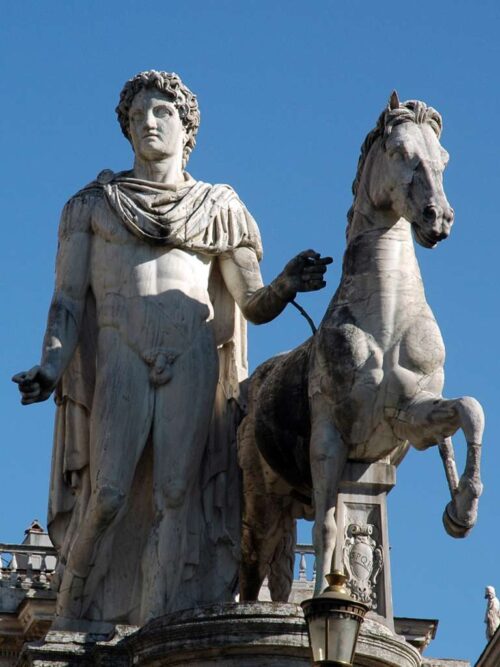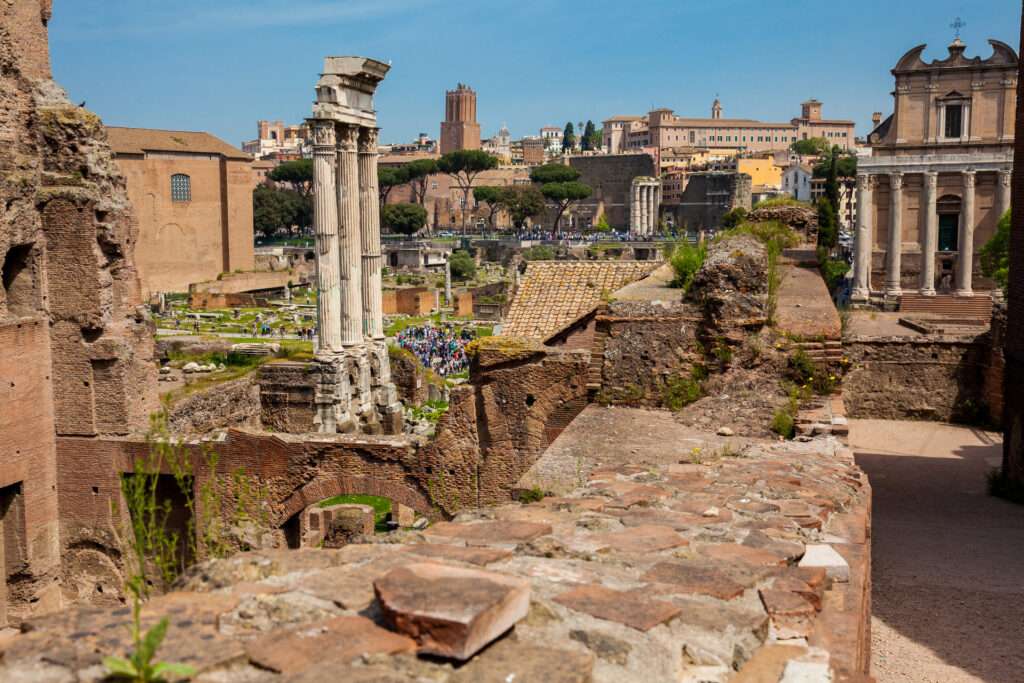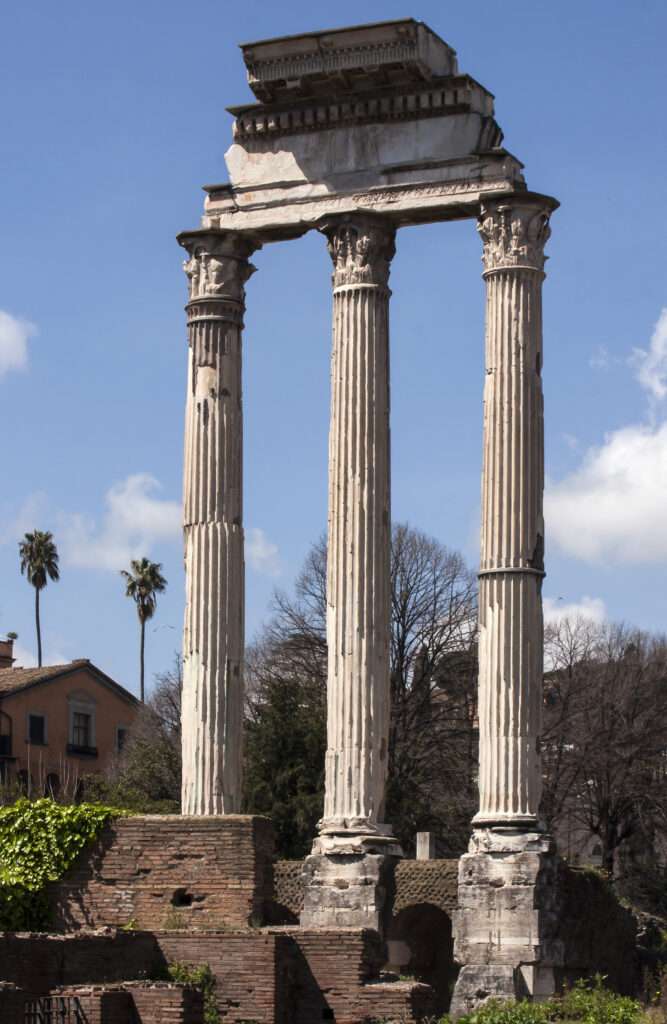The Temple of Castor and Pollux is located in the Roman Forum and is dedicated to the twin half-brother Gods Castor and Pollux (or Polydeuces), collectively known as the Dioscuri or Dioskouroi.
Who were Castor and Pollux?
The story of Castor and Pollux is complicated, with details changing quite often throughout the centuries. It is said that they are the sons of Leda, with Castor being the mortal son of Tyndareus (the king of Sparta), whereas Pollux is the immortal son of Zeus (or Jupiter in Roman mythology).
They have both been portrayed as mortal and immortal and even one of each. Whenever they are depicted as one mortal and one immortal, Castor is always described as the mortal, and Pollux is always described as immortal.
They are said to have formed the constellation of Gemini, participated in hunting the Calydonian Boar, and even featured as crew members of the Argo (of Jason and the Argonauts fame).
According to legend, Pollux asked Zeus (Jupiter) to share his immortality with Castor to keep them together.

By NoJin – Own work, CC BY-SA 3.0

By NoJin – Own work, CC BY-SA 3.0
They have been associated with horsemanship (they are regularly featured with horses) and are seen as patrons of sailors (helped by the legend of being two of the Argonauts).
They were revered in a few ancient civilizations, including the Greeks (and the various Greek states), Romans, and Etruscans.
We see similar Gods (twin gods) depicted in other civilizations. These go by the name of Ashvins (from Vedic mythology), Asvieniai (from Lithuanian mythology), and Lugal-irra and Meslamta-ea (from Mesopotamian mythology), among others. They all share similar stories, so they may share a link somewhere. It would be hard to think otherwise.
The Temple
The remains of the temple still standing in the Roman Forum are from its last reconstruction at the start of the first century AD. It was first dedicated in 484 BC, enlarged in 117 BC, and restored in 73 BC. The last dedication was done in AD 6.
The temple measured approximately 105ft x 164ft (32m x 50m) and had eight Corinthian columns along its width and eleven along its length. It was fitted with two staircases leading up to a speaker’s podium.
Legend has it that Lucius Tarquinius Superbus (the deposed last king of Rome) was attacking the Romans with the help of Latin allies. Roman dictator Aulus Postumius Albus Regillenis pledged to dedicate a temple to Castor and Pollux if the Romans were able to overcome Tarquin and the Latins.
As a side note, the mention of Aulus Postumius Albus Regillenis being a dictator was not uncommon in the Roman Republic. The republic had a mechanism that allowed a consul to be appointed a dictator for six months in times of emergency (such as war). This period could be extended if the war or emergency lasted longer than six months.
As recounted by the first century BC historian Dionysius of Halicarnassus, in his book Roman Antiquities, Book VI, XIII, he explains that two men on horseback during battle helped the Romans to victory and were seen near a fountain providing their horses with water:
“It is said that in this battle, two men on horseback, far excelling in both beauty and stature those our human stock produces, and just growing their first beard, appeared to Postumius, the dictator, and to those arrayed about him, and charged at the head of the Roman horse, striking with their spears all the Latins they encountered and driving them headlong before them. And after the flight of the Latins and the capture of their camp, the battle having come to an end in the late afternoon, two youths are said to have appeared in the same manner in the Roman Forum, attired in military garb, very tall and beautiful and of the same age, themselves retaining on their countenances as having come from a battle, the look of combatants, and the horses they led being all in a sweat. And when they had each of them watered their horses and washed them at the fountain which rises near the temple of Vesta and forms a small but deep pool, and many people stood about them and inquired if they brought any news from the camp, they related how the battle had gone and that the Romans were the victors. And it is said that after they left the Forum, they were not seen again by anyone, though great search was made for them by the man who had been left in command of the city. The next day, when those at the head of affairs received the letters from the dictator and, besides the other particulars of the battle, learned also of the appearance of the divinities, they concluded, as we may reasonably infer, that it was the same gods who had appeared in both places and were convinced that the apparitions had been those of Castor and Pollux.”
He then explains further in Book VI, XIII that the temple was built on the site where Castor and Pollux were seen:
“Of this extraordinary and wonderful appearance of these gods, there are many monuments at Rome, not only the temple of Castor and Pollux, which the city erected in the Forum at the place where their apparitions had been seen, and the adjacent fountain, which bears the names of these gods and is to this day regarded as holy, but also the costly sacrifices which the people perform each year through their chief priests in the month called Quintilis, on the day known as the Ides, the day on which they gained this victory. But above all these things, there is the procession performed after the sacrifice by those who have a public horse and who, being arrayed by tribes and centuries, ride in regular ranks on horseback as if they came from battle, crowned with olive branches and attired in the purple robes with stripes of scarlet which they call trabeae. They begin their procession from a certain temple of Mars built outside the walls and going through several parts of the city and the Forum, they pass by the temple of Castor and Pollux, sometimes to the number even of five thousand, wearing whatever rewards for valor in battle they have received from their commanders, a fine sight and worthy of the greatness of the Roman dominion. These are the things I have found both related and performed by the Romans in commemoration of the appearance of Castor and Pollux, and from these, as well as from many other important instances, one may judge how dear to the gods were the men of those times.”

Quite often, the temple was referred to as the Temple of Castor as Castor was ‘adopted’ by the Roman equites (knights).
This is somewhat confirmed in a humorous story recorded by Suetonius in his book, The Lives of the Caesars – the Life of Julius Caesar, Chapter X, when Julius Caesar was an aedile (a person responsible for the maintenance of public buildings) when his colleague was complaining about not getting any credit for the work he did with Caesar:
“When aedile, Caesar decorated not only the Comitium and the Forum with its adjacent basilicas, but the Capitol as well, building temporary colonnades for the display of a part of his material. He exhibited combats with wild beasts and stage plays too, both with his colleague and independently. The result was that Caesar alone took all the credit even for what they spent in common, and his colleague Marcus Bibulus openly said that his was the fate of Pollux: “For,” said he, “just as the temple erected in the Forum to the twin brethren, bears only the name of Castor, so the joint liberality of Caesar and myself is credited to Caesar alone.”
The temple had many uses over its lifetime. During the Republican era, it was a popular meeting spot for the Roman senate. In the Imperial era, it was used as an office for weights and measures, the treasury, and other administrative offices.
Caligula even built a temple on the Palatine Hill and cut the Temple of Castor and Pollux in two to use the temple as an entrance point to his own temple. This is re-told by Cassius Dio in his book, Roman History, Book LIX, XXVIII:
“Gaius ordered that a sacred precinct should be set apart for his worship at Miletus in the province of Asia. The reason he gave for choosing this city was that Diana had pre-empted Ephesus, Augustus Pergamum and Tiberius Smyrna; but the truth of the matter was that he desired to appropriate to his own use the large and exceedingly beautiful temple which the Milesians were building to Apollo. Thereupon, he went to still greater lengths and actually built in Rome itself two temples of his own, one that had been granted him by vote of the senate and another at his own expense on the Palatine. It seems that he had constructed a sort of lodge on the Capitoline in order, as he said, that he might dwell with Jupiter, but disdaining to take second place in this union of households and blaming the god for occupying the Capitoline ahead of him, he hastened to erect another temple on the Palatine and wished to transfer to it the statue of the Olympian Zeus after re-modeling it to resemble himself. But he found this to be impossible, for the ship built to bring it was shattered by thunderbolts, and loud laughter was heard every time that anybody approached as if to take hold of the pedestal; accordingly, after uttering threats against the statue, he set up a new one of himself. He cut in two the temple of Castor and Pollux in the Roman Forum and made through it an approach to the Palace running directly between the two statues, in order, as he was wont to say, that he might have the Dioscuri for gate-keepers.”

Suetonius also recorded this version of events in his book, The Lives of the Caesars – the Life of Caligula, Chapter XXII:
“And he came near assuming a crown at once and changing the semblance of a principate into the form of a monarchy. But on being reminded that he had risen above the elevation both of princes and kings, he began from that time on to lay claim to divine majesty, for after giving orders that such statues of the gods as were especially famous for their sanctity or their artistic merit, including that of Jupiter of Olympia, should be brought from Greece, in order to remove their heads and put his own in their place, he built out a part of the Palace as far as the Forum, and making the temple of Castor and Pollux its vestibule, he often took his place between the divine brethren and exhibited himself there to be worshipped by those who presented themselves, and some hailed him as Jupiter Latiaris.”
It is hard to know how many of these stories are true, as details can be embellished. This can be easier when the person being written about is not well-liked. However, when someone has absolute power, there remains a good chance that those powers are abused, and people can sometimes lose touch with reality.
Not much of the temple remains. However, the most notable remains are three columns still standing. This in itself is easily recognizable and one of the enduring images when we think of Roman ruins.
Sources:
Roman Antiquities – Dionysius of Halicarnassus (Thayer)
The Lives of the Caesars – Suetonius (Thayer)
Roman History – Cassius Dio (Thayer)

